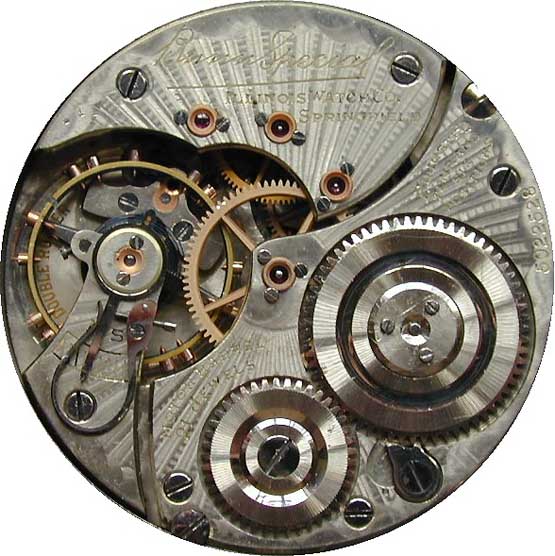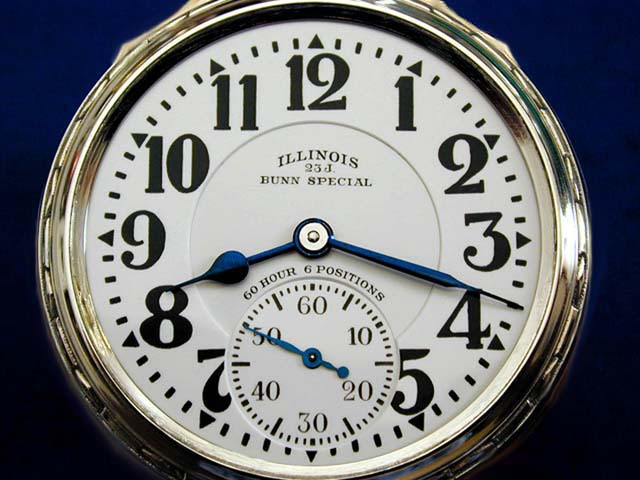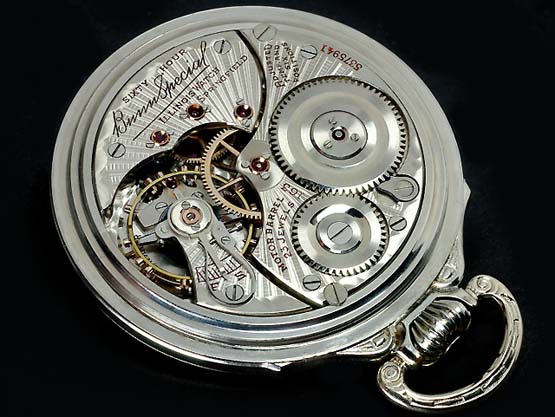
| WWT Shows | CLICK TO: Join and Support Internet Horology Club 185™ | IHC185™ Forums |

|
• Check Out Our... • • TWO Book Offer! • |
Welcome Aboard IHC185™  Internet Horology Club 185
Internet Horology Club 185  IHC185™ Discussion Site Main Page
IHC185™ Discussion Site Main Page  Open to the World RESEARCH FORUMS
Open to the World RESEARCH FORUMS  Illinois Watch Company Research Forum
Illinois Watch Company Research Forum  Now that the wonderful Bunn 163 auction is over...
Now that the wonderful Bunn 163 auction is over...
 Internet Horology Club 185
Internet Horology Club 185  IHC185™ Discussion Site Main Page
IHC185™ Discussion Site Main Page  Open to the World RESEARCH FORUMS
Open to the World RESEARCH FORUMS  Illinois Watch Company Research Forum
Illinois Watch Company Research Forum  Now that the wonderful Bunn 163 auction is over...
Now that the wonderful Bunn 163 auction is over...Go  | New Topic  | Find-Or-Search  | Notify  | Tools  | Reply to Post  |  |
| IHC President Life Member |
Larry, Serious collecting of Bunn Specials is not for the faint of heart or the thin of wallet. Your watch is indeed a "163 Bunn Special Type I" of which we believe about 3,800 were produced. The markings are very distinctive on each of the three 163 variants, the two 163 Elinvar variants and the two 163A Elinvar variants. This is a complicated subject. In order to help we could post images of each of the seven 23-Jewel 163 Variants along with the Type I, Type II, and Type III Sixty-Hour Bunn Specials. That would be ten movements. If there is interest I could take on that project. Hope this helps, Lindell | |||
Larry The features that make yours a type I is the location of the 163 marking, yours being on the bbl bridge next to the center wheel. A type IR has the 163 marking on the bbl bridge next to the movement edge - about 1000 made. There's a whole 'nother set of types when you add the elinvar markings that come later. Then, they moved the 23 jewels marking around and created more types. These were not marketing distinction from the factory, but rather a means by which collectors can distinguish the variations, courtesy of Meggers & Ehrhardt. I still have to look them up in the book. Charlie | ||||
| Illinois Expert |
The exact number of movements produced in any of the 163 (or 161) Bunn Specials is especially problematical, since several of the production runs are now known to be split between different versions. If you look at Meggers & Ehrhardt, p. 416, they listed the run of two thousand movements from 5,420,001 - 5,422,000 as split between Type I & I-E. As more and more movements from this and other "split" production runs appear, we must continually update the total production counts to reflect new information. For the most part, these runs tended to be in groups of 100, although even some of these are split. Meggers assumed that each split run was evenly divided when he arrived at his production count estimates, and it's difficult to come up with a better ratio for this determination. New watches seen since the book was published (and it listed 4,000) suggests that the total of 163 Type I movements is more like 3,700. Russ | |||
Let's see if I can help a little at Russ's suggestion. I look forward to Lindell posting his usual excellent photos of each type in the near future. Let's start from the beginning of the 60 Hour Bunn Specials and list 23 Jewel only. There are many split runs and even split 100 blocks and the research has taken me many years of which I have contributed many numbers to the Illinois CD, but that said, as accurate as I have knowledge today, there are low and high parameters of which no fewer than that or no more than that are produced, they are as follows: 1) 23J 60 Hour Bunn Special Type I ... (900-1,100 approx.) 2) 23J 60 Hour Bunn Special Type II ... (500-600 approx.) 3) 23J 60 Hour Bunn Special Type III ... (11,200 approx.) 4) 163 Type IR ... (880 produced approx.) 5) 163 Type I ... (3,800 produced approx.) 6) 163 Type II ... (50 produced approx.) 7) 163 Type I Elinvar ... (900-1,100 approx.) 8) 163 Type II Elinvar ... (250-350 approx.) 9) 163A II B ... (1,800 approx.) 10) 163A IIP ... (1,900 approx.) Now , that's the easy part, all the figures are approximate but the parameters are as accurate as possible based on what has been seen and recorded thus far. As more watches are recorded we can fine tune the figures more precisely. I will not go into what are known to exist in the scarce variants but they are very few for sure and nice examples can bring exorbirant prices. I MYSELF being a valid top bidder. The hard part is deciding how the runs and sometimes even 100 blocks were intermingled with various types. Some 100 blocks in the 163's around 5.4 million can contain as many as 3 different variants and there is where the research gets both interesting and complicated depending on one's interest level. I have always been facinated with the numbers of the variants and love to see the complexities with which they were randomly assembled due to the slow economic times of the early 1930's but even in good times of the late 1920's there were split runs between type I's II's and III's. Let's hope more folks start contributing to the database by reporting what they find here on the IHC 185 Site. So get out there and hunt those rare watches down!! I will make mention that of total Illinois production, the 23J 60 Hour Bunn Specials total less than 23 thousand watches. This is only 4 tenths of 1 percent of total production! Most are worn, tarnished, slightly rusty, damaged, scratched , broken , botched, badly repaired and lacking original dials and cases. If you are lucky enough to find an excellent example or better, especially in the rarer variants, hang on to it, as it will only apprciate in value as the years go by. Gone are the days when I could buy a 163, 163E or 163A in near mint condition for 6-800 dollars as I could in the mid 1990's. Happy Hunting!!! ... | ||||
| Illinois Expert |
Thanks, Mike, not only for providing all this excellent information, but also for confirming what I said: You guys know a lot more about these than I do! Keep up the great work! Russ | |||
Without information like this, horology doesn't have a chance for a future! Passing on this kind of information is what keeps horology alive, LITERALLY! Starting as an Elgin collector, it has been hard to learn about other watches, it's information like this that helps OTHERS so very much. It makes for a wonderful starting point, especially when your in the dark about a watch, this kind of posting touches on some fantastic points, and gets the ball rolling. Thank you all for the posts to this topic. Sheila | ||||
I completely agree with Sheila's comments. Reading information like what has been posted here as well as in other topics (including the archived topics) only increases my desire to expand my collecting beyond Elgins. -Steve | ||||
Thanks to all for the kind comments,I have enjoyed learning from all of you as well since I joined IHC 185. It is a real joy to "turn the light bulb on" so to speak for a fellow collector, they may indeed find a watch that may then be able to come our way as a result of our sharing knowledge. So, lets have one more bit of Illinois trivia for you to digest that may place importance on rarity. Here goes: There are only around 18,000 possibilities for a 23J 60Hr Bunn Special to have a marked dial from 1928 through end of production of the 163A's in the late 1930's. And not all of them had a marked dial, but that said, let's just say or pretend that they all did, so with only 18,000 possible marked dials for 23 Jewel out there, only around 1 in 5, to upwards of only 1 in 10 of these 23J Bunns had a marked montgomery dial so those could only add up to around 1800 to 3600 marked mongomery dials at the most in my opinion. Of those only around 1 in 10 or so would still be a perfect example today, so that is around 180 to 360 perfect marked Montgomery dials still left for us to collect . Let's say 200-400 perfect marked montgomery 23 jewel dials for simplicity. That's a good guesstimate of what's out there. That should give you a different perspective on how desirable one of those dials in perfect shape really is to us serious collectors. So the next time you see a perfect marked montgomery 23 Jewel Bunn Special dial, well hopefully, you get the point. Buy that watch!! Lindell or I might try and talk you out of it, . | ||||
| Illinois Expert |
Mike wrote about the rarity of Montgomery dials for 23J 60Hr Bunn Specials, but there are some items that are even more rare. Bill Meggers included in his book on the Illinois Watch Co., for example, two references to "factory variants" (see photo p. 125 and p. 113 for descriptions) Unfortunately, when the book was printed, the photos for 125-6 and 127-4 were switched, so to see the photo of the 161(A) FV you have to look at 127-4 (not that all this wasn't already confusing enough as it is!) I like to think of these factory variants as being like coins that were mis-struck, or stamps that were mis-printed -- really rare and sometimes even one-of-a-kind. In my opinion, these two watches (and others like them) simply skipped a step in the stamping/engraving process -- a "quality control" issue if you will. And you really have to look hard AND know what you're looking for to spot them. Some of us have debated the "authenticity" of my watch pictured below, and I won't rehash all that here. What's "different" about this watch is the fact that, although it's falls within a run of 21J 60Hr Type III Bunn Specials, the "Sixty Hour" marking is missing on the train bridge at the top of the photo. I believe this represents another example of a "factory variant". The only problem is the S/N stamped on the back of train bridges contain only the last FOUR DIGITS of the S/N. And, as Mike & Terry have pointed out, there are other production runs of Bunn Specials with the same last four digits which ARE NOT 60Hr movements (and therefore wouldn't have the "Sixty Hour" marking). If this were the case, the S/N on the barrel bridge (5,022,528) would be for a 60Hr Type III, but the train bridge w/o the "Sixty Hour" marking COULD have come from another watch, one that did NOT have a "Sixty Hour" marking to begin with. Conversely, it COULD be the original train bridge from the original movement, and represent another Factory Variant. The point I'm trying to make is that one has to look closely and know what you're looking for to spot rare watches that don't exactly "jump out" at you. In looking at this watch, for example, a novice collector might not realize that 16s 21j Bunn Specials marked "Motor Barrel" should also be marked "Sixty Hour", "Motor Barrel 60", or both. Whatever the real story behind this watch is, the photo is here for your enjoyment. Russ  | |||
| IHC President Life Member |
Thanks Russ, Very interesting and mysterious watch you have there my friend! Mike mentioned the rarity of "Marked Montgomery" dials used on the 1928 and later Type III Bunn Specials as well as all of the 163 Bunn Special variants. Note, as Mike made clear in his post above, these dials were offered beginning in 1928 and through the end of 163A production. Therefore, counting that entire range of production there were only about 18,000 watches that could have originally come from the factory with one the four extremely desirable dials you will see illustrated below. Below, in the next four posts we share images of those four dials. First, the "Heavy Gothic 23" or "HG23" Dial... | |||
| IHC President Life Member |
Second, the "Marked Montgomery 23" or "MM23" Dial... | |||
| IHC President Life Member |
Third, the "Heavy Gothic 23J Variant" or "HG23J" Dial...  | |||
| IHC President Life Member |
Fourth, the "Marked Montgomery 23J Variant" or "MM23J" Dial... | |||
| IHC Life Member Wristwatch Host |
Lindell, It ought to be against the law for a guy to have those 4 dials in his collection. | |||
Lindell, I agree with Tony--this should be illegal to own all four of these examples. Seriously, those four Bunn Special marked dials are fabulous--and so is the photography with crystals in place. | ||||
I have always wondered why Illinois watches were never offered with a 21 jewel Bunn Special Montgomery marked dial as the 23 jewel movements were--only the one variant without the Montgomery figures was offered on 21's? ? ? ? ? Wonder why? | ||||
| IHC President Life Member |
Thanks for the kind words guys! Larry, I too have often wondered why they apparently offered only one style of marked "21-Jewel 60-Hour" dial. Evidently they found that buyers of more expensive 23-Jewel movements were more likely to load up on optional dials and for that matter spring for more expensive cases as well. Below, the marked "21-Jewel 60-Hour" or "MP-21" dial... | |||
STOP ! STOP ! STOP! I don't think I can stand anymore! What FANTASTIC "stuff" Those dials are GORGEOUS and the information is more than I can stand! This is OUTSTANDING! This is the information and pictures I drool over, thank you guys. My printer will burn tonight! I'm going to print up the information and print those dials right away, and if I see them I will let everyone know about them. They are way out of my purse size, but I know that many here would love to have them. A Toast, Here's to finding the rarest of the rare! (__)> THANK YOU EVERYONE! Sheila | ||||
Lindell I have a 21j Bunn Special marked 60 Hour c. 1926 with a similar dial but without the Bunn Special or 21 jewel 60 hour markings. Does my watch have an incorrect dial? Also, let me add wonder (and not a little bit of envy) at your photos. They are striking and (on another thread) I'd like to know how you actually do it. Also my thanks as well for this entire thread. I can't imagine when even half of this Illinois stuff will begin to sink into my limited brain. Ron | ||||
| IHC President Life Member |
Thanks Ron, Freely sharing what we have and what we know, is fundamental to the full enjoyment of this hobby. Your 1926 Bunn Special sounds right to me. Each of the dials we have shown thus far in this topic came into use after the 1928 takeover of Illinois by Hamilton and therefore are considered as belonging only on those later watches. Most Illinois collectors accept these marked dials and the later style blue hands you see in the dial images only after about the 5,008,001 serial number (early 1928) area. Others may differ and there could be exceptions, but this is the "non-argumentative" way most of us want to align our collections. I have personally observed some of the best known watch sellers at ***** events changing movements from case-to-case (like ladies trying on all the shoe styles) because they think their new combination might realize a greater profit. Very few retail sellers have taken the time to learn what is correct and even fewer care about authenticity. For those reasons far too many watches we find are a sad mixture of what were once unrelated components. We now have the opportunity to make our watches correct, the way they could have been originally. Lindell | |||
| IHC Vice President Pitfalls Moderator IHC Life Member |
Very impressive piece of horological education Lin! Good idea to take the photos sans crystal to show the dials better. Best Regards, Ed | |||
| Powered by Social Strata |
| Your request is being processed... |
|
Welcome Aboard IHC185™  Internet Horology Club 185
Internet Horology Club 185  IHC185™ Discussion Site Main Page
IHC185™ Discussion Site Main Page  Open to the World RESEARCH FORUMS
Open to the World RESEARCH FORUMS  Illinois Watch Company Research Forum
Illinois Watch Company Research Forum  Now that the wonderful Bunn 163 auction is over...
Now that the wonderful Bunn 163 auction is over...
 Internet Horology Club 185
Internet Horology Club 185  IHC185™ Discussion Site Main Page
IHC185™ Discussion Site Main Page  Open to the World RESEARCH FORUMS
Open to the World RESEARCH FORUMS  Illinois Watch Company Research Forum
Illinois Watch Company Research Forum  Now that the wonderful Bunn 163 auction is over...
Now that the wonderful Bunn 163 auction is over...©2002-2025 Internet Horology Club 185™ - Lindell V. Riddle President - All Rights Reserved Worldwide


